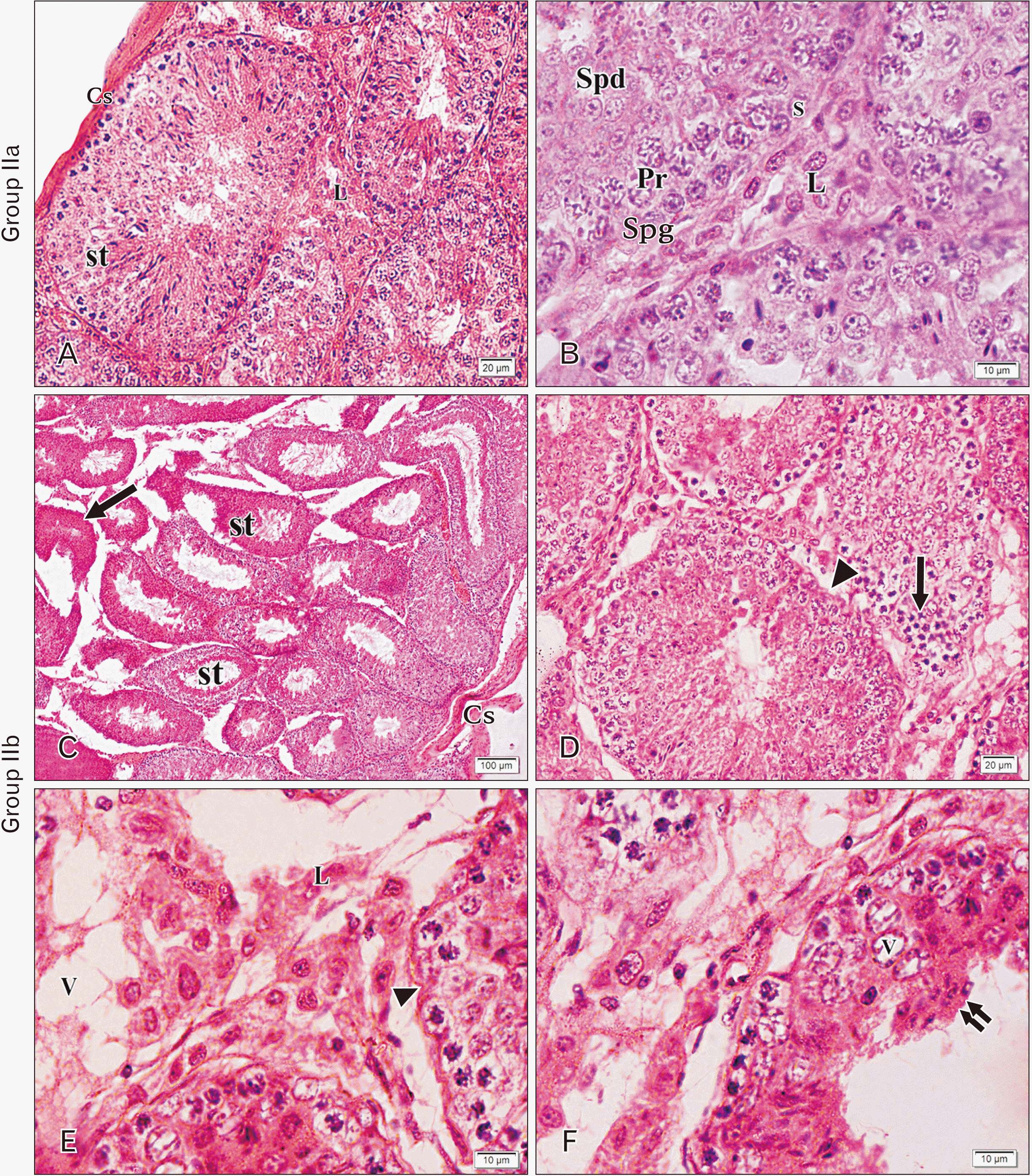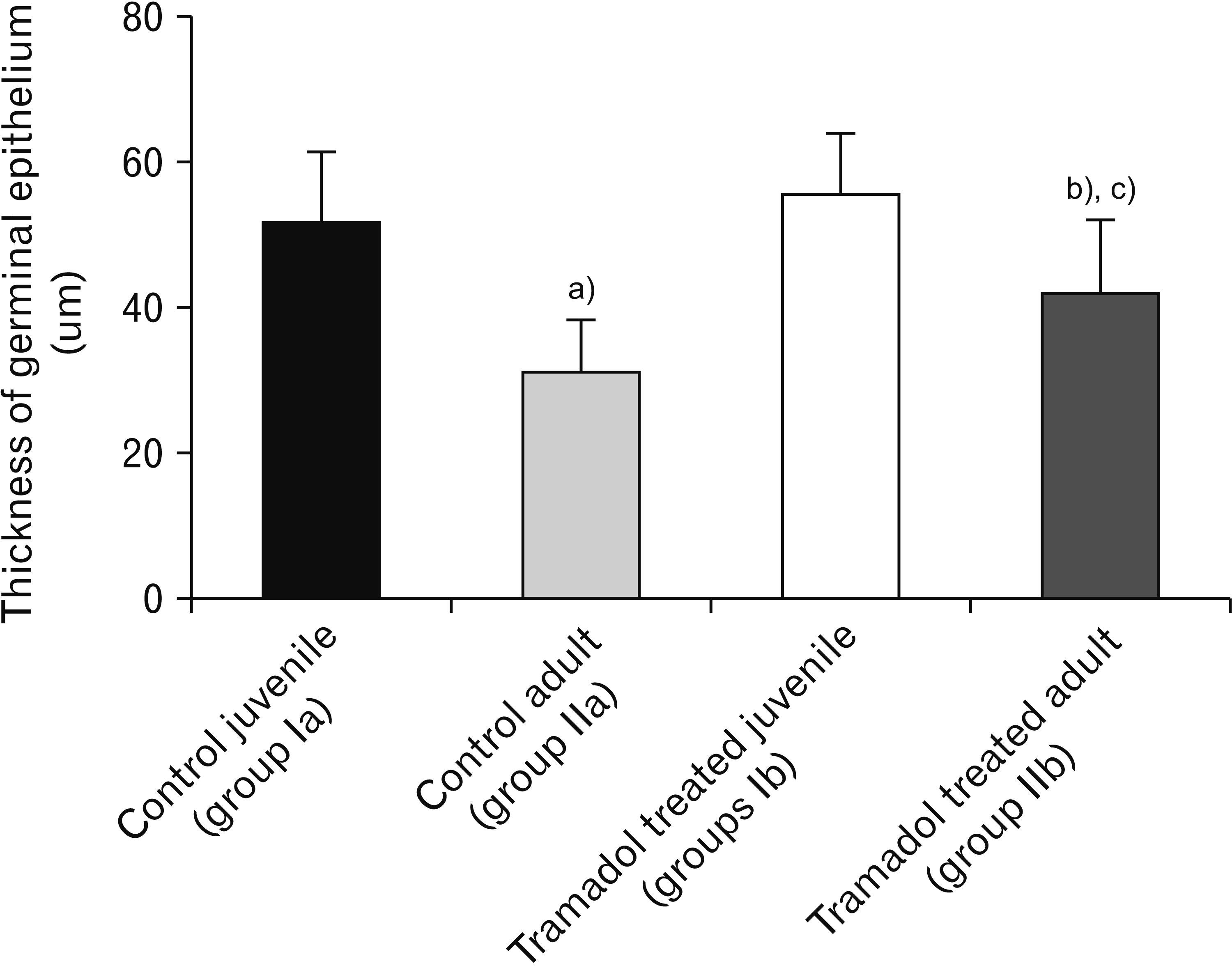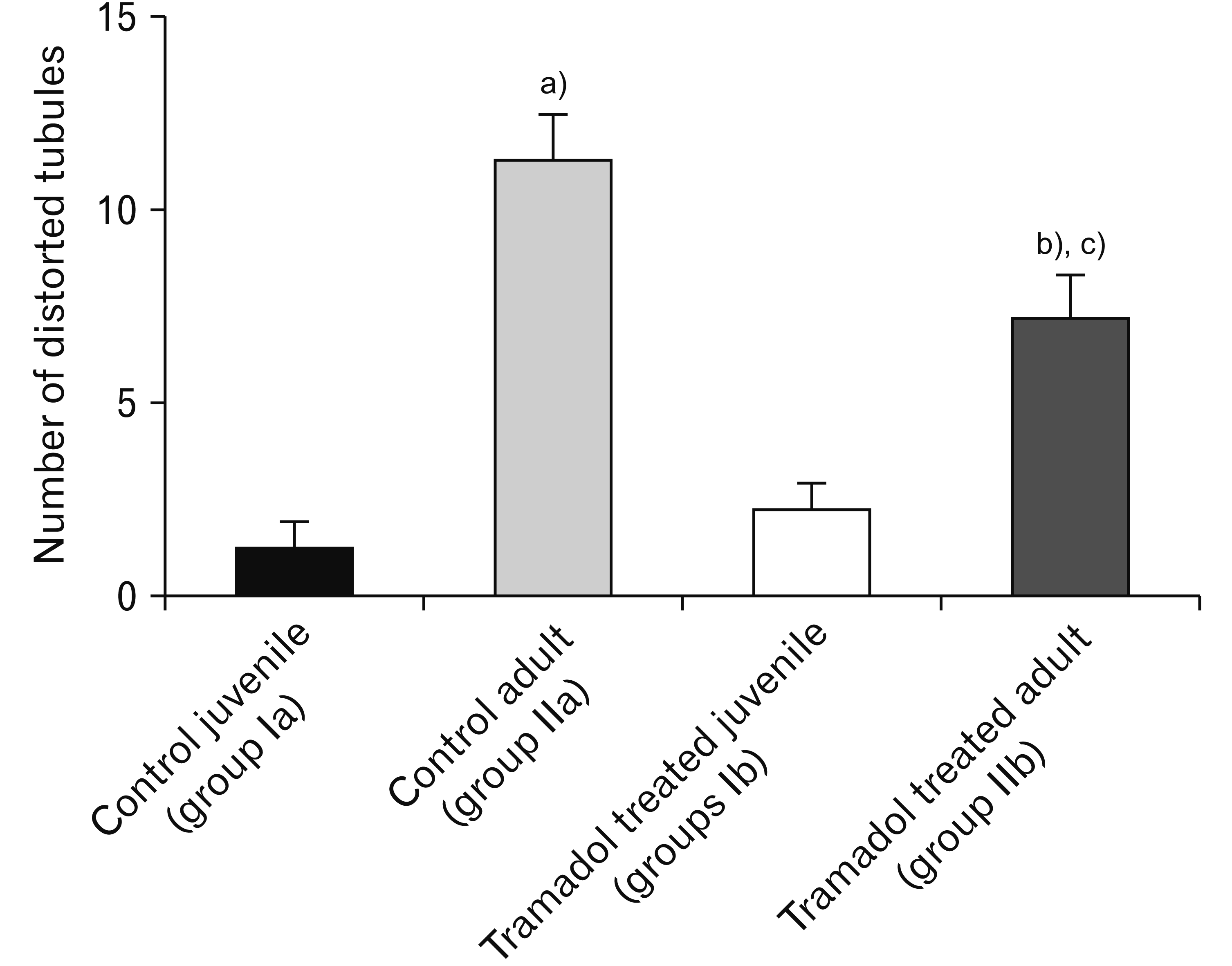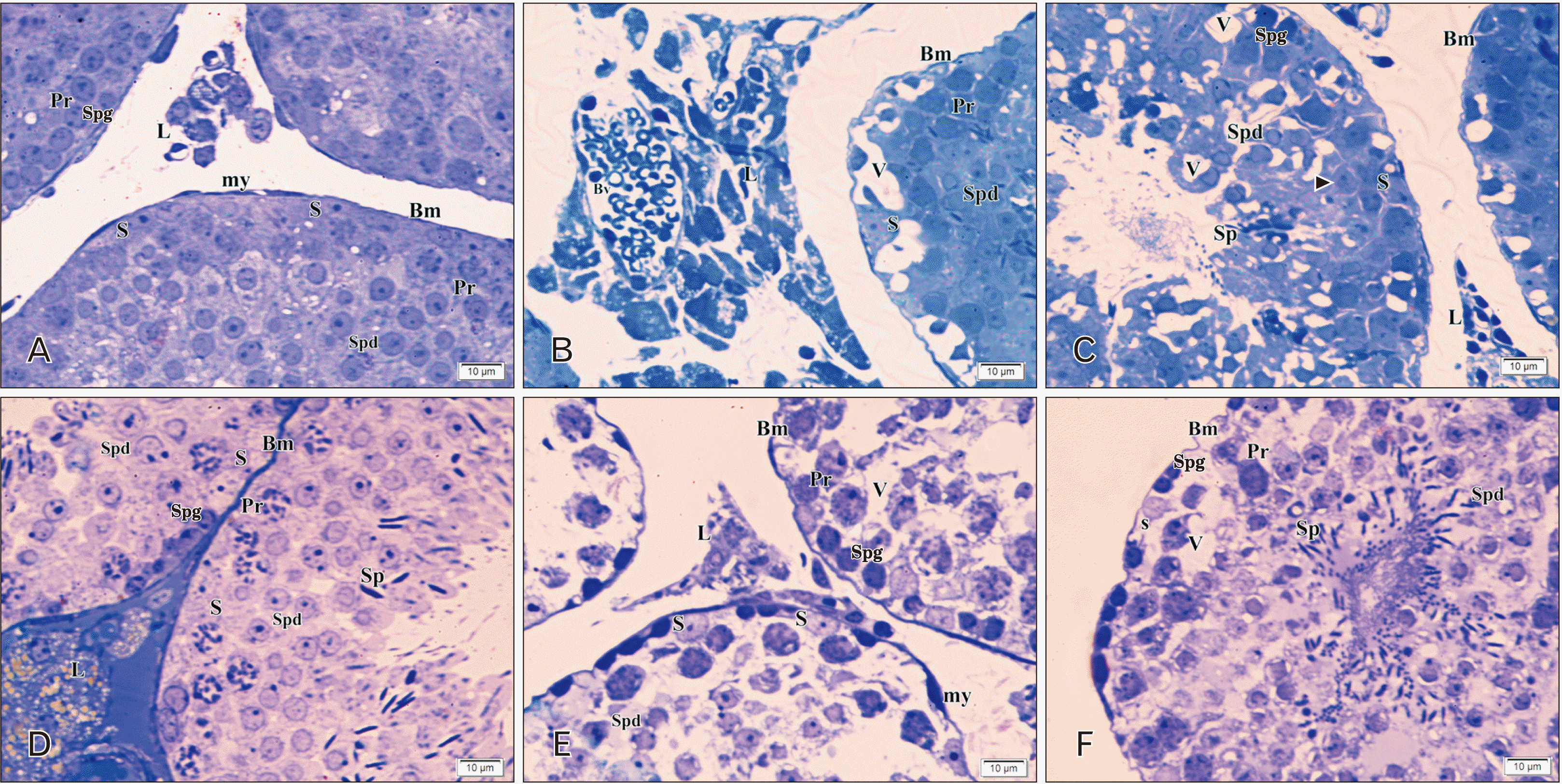1. Candeletti S, Lopetuso G, Cannarsa R, Cavina C, Romualdi P. 2006; Effects of prolonged treatment with the opiate tramadol on prodynorphin gene expression in rat CNS. J Mol Neurosci. 30:341–7. DOI:
10.1385/JMN:30:3:341. PMID:
17401159.

3. Miotto K, Cho AK, Khalil MA, Blanco K, Sasaki JD, Rawson R. 2017; Trends in tramadol: pharmacology, metabolism, and misuse. Anesth Analg. 124:44–51. DOI:
10.1213/ANE.0000000000001683. PMID:
27861439.
8. Aloisi AM, Ceccarelli I, Fiorenzani P, Maddalena M, Rossi A, Tomei V, Sorda G, Danielli B, Rovini M, Cappelli A, Anzini M, Giordano A. 2010; Aromatase and 5-alpha reductase gene expression: modulation by pain and morphine treatment in male rats. Mol Pain. 6:69. DOI:
10.1186/1744-8069-6-69. PMID:
20977699. PMCID:
PMC2978140.

9. Ghoneim FM, Khalaf HA, Elsamanoudy AZ, Helaly AN. 2014; Effect of chronic usage of tramadol on motor cerebral cortex and testicular tissues of adult male albino rats and the effect of its withdrawal: histological, immunohistochemical and biochemical study. Int J Clin Exp Pathol. 7:7323–41. PMID:
25550769. PMCID:
PMC4270590.
10. Bar-Or D, Salottolo KM, Orlando A, Winkler JV. Tramadol ODT Study Group. 2012; A randomized double-blind, placebo-controlled multicenter study to evaluate the efficacy and safety of two doses of the tramadol orally disintegrating tablet for the treatment of premature ejaculation within less than 2 minutes. Eur Urol. 61:736–43. DOI:
10.1016/j.eururo.2011.08.039. PMID:
21889833.

12. Bancroft JD, Layton C. Suvarna SK, Layton C, Bancroft JD, editors. 2013. The hematoxylins and eosin. Bancroft's Theory and Practice of Histological Techniques. 7th ed. Churchill Livingstone of Elsevier;Philadelphia: p. 173–86. DOI:
10.1016/B978-0-7020-4226-3.00010-X.

13. Glauert AM, Lewis PR. 2014. Biological specimen preparation for transmission electron microscopy. Princeton University Press;Princeton: DOI:
10.1002/0471140856.tx1603s12.
14. O'Callaghan JP, Jensen KF. 1992; Enhanced expression of glial fibrillary acidic protein and the cupric silver degeneration reaction can be used as sensitive and early indicators of neurotoxicity. Neurotoxicology. 13:113–22. PMID:
1508411.
15. Martyn-St James M, Cooper K, Kaltenthaler E, Dickinson K, Cantrell A, Wylie K, Frodsham L, Hood C. 2015; Tramadol for premature ejaculation: a systematic review and meta-analysis. BMC Urol. 15:6. DOI:
10.1186/1471-2490-15-6. PMID:
25636495. PMCID:
PMC4417346.

16. Ahmed AI, El-Dawy K, Fawzy MM, Abdallah HA, Elsaid HN, Elmesslamy WO. 2018; Retrospective review of tramadol abuse. Slov Vet Res. 55(Suppl 20):471–83.
17. Abdellatief RB, Elgamal DA, Mohamed EE. 2015; Effects of chronic tramadol administration on testicular tissue in rats: an experimental study. Andrologia. 47:674–9. DOI:
10.1111/and.12316. PMID:
25228095.

18. Cerilli LA, Kuang W, Rogers D. 2010; A practical approach to testicular biopsy interpretation for male infertility. Arch Pathol Lab Med. 134:1197–204. DOI:
10.5858/2009-0379-RA.1. PMID:
20670143.

19. Salama N, Bergh A, Damber JE. 2003; The changes in testicular vascular permeability during progression of the experimental varicocele. Eur Urol. 43:84–91. DOI:
10.1016/S0302-2838(02)00501-8. PMID:
12507549.

20. Awadalla EA, Salah-Eldin A. 2005; Histopathological and molecular studies on tramadol mediated hepato-renal toxicity in rats. J Pharm Biol Sci. 10:90–102.
21. Essam Hafez M, Sahar Issa Y, Safaa Abdel Rahman M. 2015; Parenchymatous toxicity of tramadol: histopathological and biochemical study. J Alcohol Drug Depend. 3:225. DOI:
10.4172/2329-6488.1000225.

22. Elkhateeb A, El Khishin I, Megahed O, Mazen F. 2015; Effect of Nigella sativa Linn oil on tramadol-induced hepato- and nephrotoxicity in adult male albino rats. Toxicol Rep. 2:512–9. DOI:
10.1016/j.toxrep.2015.03.002. PMID:
28962386. PMCID:
PMC5598165.

23. Mohamed D, Saber A, Omar A, Soliman A. 2014; Effect of cadmium on the testes of adult albino rats and the ameliorating effect of zinc and vitamin E. Br J Sci. 11:72–95.
24. Nolte T, Harleman JH, Jahn W. 1995; Histopathology of chemically induced testicular atrophy in rats. Exp Toxicol Pathol. 47:267–86. DOI:
10.1016/S0940-2993(11)80260-5. PMID:
8855122.

26. Ahmed MA, Kurkar A. 2014; Effects of opioid (tramadol) treatment on testicular functions in adult male rats: the role of nitric oxide and oxidative stress. Clin Exp Pharmacol Physiol. 41:317–23. DOI:
10.1111/1440-1681.12213. PMID:
24472030.

27. Zhang YT, Zheng QS, Pan J, Zheng RL. 2004; Oxidative damage of biomolecules in mouse liver induced by morphine and protected by antioxidants. Basic Clin Pharmacol Toxicol. 95:53–8. DOI:
10.1111/j.1742-7843.2004.950202.x. PMID:
15379780.

28. Berruti G. 2006; Signaling events during male germ cell differentiation: update, 2006. Front Biosci. 11:2144–56. DOI:
10.2741/1957. PMID:
16720301.

29. Lombardo F, Sgrò P, Salacone P, Gilio B, Gandini L, Dondero F, Jannini EA, Lenzi A. 2005; Androgens and fertility. J Endocrinol Invest. 28(3 Suppl):51–5. DOI:
10.1111/j.1365-2605.2005.00585.x. PMID:
16236065.
30. Soliman HM, Wagih HM, Attia GM, Algaidi SA. 2014; Light and electron microscopic study on the effect of antischizophrenic drugs on the structure of seminiferous tubules of adult male albino rats. Folia Histochem Cytobiol. 52:335–49. DOI:
10.5603/FHC.a2014.0038. PMID:
25535927.

31. Heidari Z, Mahmoudzadeh-Sagheb H, Kohan F. 2012; A quantitative and qualitative study of rat testis following administration of methadone and buprenorphine. Int J High Risk Behav Addict. 1:14–7. DOI:
10.5812/ijhrba.4119.

32. Sorge RE, Stewart J. 2006; The effects of long-term chronic buprenorphine treatment on the locomotor and nucleus accumbens dopamine response to acute heroin and cocaine in rats. Pharmacol Biochem Behav. 84:300–5. DOI:
10.1016/j.pbb.2006.05.013. PMID:
16806444.

33. Rashed RMA, Mohamed IK, El-Alfy SH. 2010; Effects of two different doses of melatonin on the spermatogenic cells of rat testes: a light and electron microscopic study. Egypt J Histol. 33:819–35.
34. Manivannan B, Mittal R, Goyal S, Ansari AS, Lohiya NK. 2009; Sperm characteristics and ultrastructure of testes of rats after long-term treatment with the methanol subfraction of Carica papaya seeds. Asian J Androl. 11:583–99. DOI:
10.1038/aja.2009.25. PMID:
19648937. PMCID:
PMC3735006.

35. Jezek D, Simunić-Banek L, Pezerović-Panijan R. 1993; Effects of high doses of testosterone propionate and testosterone enanthate on rat seminiferous tubules--a stereological and cytological study. Arch Toxicol. 67:131–40. DOI:
10.1007/BF01973684. PMID:
8481101.
36. Sharpe RM, McKinnell C, Kivlin C, Fisher JS. 2003; Proliferation and functional maturation of Sertoli cells, and their relevance to disorders of testis function in adulthood. Reproduction. 125:769–84. DOI:
10.1530/rep.0.1250769. PMID:
12773099.

37. Mohamed HM, Mahmoud AM. 2019; Chronic exposure to the opioid tramadol induces oxidative damage, inflammation and apoptosis, and alters cerebral monoamine neurotransmitters in rats. Biomed Pharmacother. 110:239–47. DOI:
10.1016/j.biopha.2018.11.141. PMID:
30508735.

39. Erkkilä K, Aito H, Aalto K, Pentikäinen V, Dunkel L. 2002; Lactate inhibits germ cell apoptosis in the human testis. Mol Hum Reprod. 8:109–17. DOI:
10.1093/molehr/8.2.109. PMID:
11818513.

41. Newton AP, Cadena SM, Rocha ME, Carnieri EG, Martinelli de Oliveira MB. 2005; Effect of triclosan (TRN) on energy-linked functions of rat liver mitochondria. Toxicol Lett. 160:49–59. DOI:
10.1016/j.toxlet.2005.06.004. PMID:
16023799.

42. Tamura I, Kanbara Y, Saito M, Horimoto K, Satoh M, Yamamoto H, Oyama Y. 2012; Triclosan, an antibacterial agent, increases intracellular Zn(2+) concentration in rat thymocytes: its relation to oxidative stress. Chemosphere. 86:70–5. DOI:
10.1016/j.chemosphere.2011.09.009. PMID:
22000841.

43. Abdel-Zaher AO, Abdel-Rahman MS, Elwasei FM. 2011; Protective effect of Nigella sativa oil against tramadol-induced tolerance and dependence in mice: role of nitric oxide and oxidative stress. Neurotoxicology. 32:725–33. DOI:
10.1016/j.neuro.2011.08.001. PMID:
21855572.

44. Halawa AM. 2010; Effect of sildenafil administration on ischemic reperfusion of the testis in adult albino rat light and electron microscopic study. Egypt J Histol. 2:380–95.
45. Gouda ZA, Selim AO. 2013; A possible correlation between the testicular structure and short photoperiod exposure in young albino rats: light and electron microscopic study. Egypt J Histol. 36:28–38. DOI:
10.1097/01.EHX.0000423980.95382.0c.

46. Bassiony MM, Youssef UM, El-Gohari H. 2020; Free testosterone and prolactin levels and sperm morphology and function among male patients with tramadol abuse: a case-control study. J Clin Psychopharmacol. 40:405–8. DOI:
10.1097/JCP.0000000000001223. PMID:
32639294.

47. Popovic M, Janicijevic-Hudomal S, Kaurinovic B, Rasic J, Trivic S, Vojnović M. 2009; Antioxidant effects of some drugs on immobilization stress combined with cold restraint stress. Molecules. 14:4505–16. DOI:
10.3390/molecules14114505. PMID:
19924083. PMCID:
PMC6254731.

48. El-Gaafarawi II. 2006; Biochemical toxicity induced by tramadol administration in male rats. Egypt J Hosp Med. 23:353–62. DOI:
10.21608/ejhm.2006.17946.





 PDF
PDF Citation
Citation Print
Print












 XML Download
XML Download